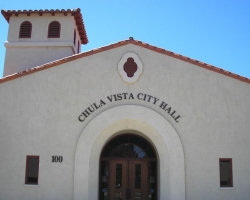The city government of Chula Vista keeps pleading that they need more money, that the city is financially poor. Is that true? Yes it is. This is why:
The population of Chula Vista is now more than a quarter-million people, well on its way to be at least a third-of-a-million people. That’s big, and yet the city has relatively little commercial development (Chula Vista is near the bottom in terms of sales-tax revenue per resident in the County), and even less industrial developments. Commercial” and industrial are what create jobs and a tax base.
As you can see by Table 1, Chula Vista is fourth from the top in terms of ‘household incomes’ of eleven cities above 58,000 (National City) in San Diego County, but in Table 2 Chula Vista is dead last in terms of dollars-per-resident in their General Funds. And dead last by 10 percent!
In 1989 and again in 2005, Chula Vista updated its General Plan. That is when planners, with public participation, create the outline in the General Plan for developing areas like EastLake and Otay Ranch before they are built. The planners produced balanced plan of ‘residential,’ ‘commercial,’ and ‘industrial,’ as you would expect of planners. But the ink was barely dry before the city councils started changing commercial and hundreds of acres of industrial to residential at the behest of developers.
We have no knowledge of residential acreage ever being changed to commercial or industrial!
We have been blessed, in a sense, by having three developers (EastLake, Otay Ranch, and Home Fed) who have been in for the long run, for decades. They have been as anxious to create a nice town as much as any of us, but unfortunately for the long run, they specialize in residential, not commercial nor industrial.
And succeeding city councils have been very willing to accommodate them by agreeing to their requests to change commercial, and especially industrial,’ to ‘residential.’ Crossroads has opposed every proposal to change ‘industrial’ to just more ‘residential,’ but we lost every time.
So now we are all paying the price by having not created much commercial and very little industrial — and therefore, not creating a job-base or a tax-base. Thus the continuing need to raise our sales-tax, about the only tax the city controls.
It is also why 80,000 Chula Vistans have to leave Chula Vista every morning to go to work.
Peter Watry is chairman of Crossroads II.
Table 1
Median household income*
Encinitas: $97,232
Carlsbad: $89,639
San Diego: $64,767
Chula Vista: $60,589
Oceanside: $55,988
La Mesa: $54,781
San Marcos: $54,769
Vista: $50,102
Escondido:$49,154
El Cajon: $43,533
National City: $37,136
* SANDAG estimates for 2016 in 2010 dollars
Table 2
General Fund expenditures per person*
Carlsbad: $1,290 Encinitas: $1,045
San Diego: $1,030
National City:$902
Oceanside: $825
La Mesa: $802
Vista: $779
San Marcos: $ 787
El Cajon: $697
Escondido: $659
Chula Vista: $ 629
*SANDAG 2016 pop. est.; 2017-18 city budgets)












